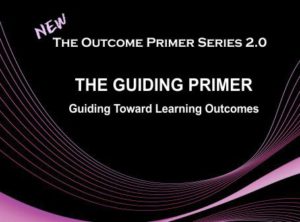The GUIDING Primer: Guiding Toward Learning Outcomes
By: Don Prickel and Ruth Stiehl
| PREFACE: THE OUTCOME Primers Series 2.0 | |||
| Once a Fad—Now a Fact! | xiii | ||
| Distinguishing Our Work | xiv | ||
| PART ONE: How the Instructor’s Role Changes with the Introduction of Learning Outcomes | |||
| Change happens through a slight shift in imagination—Mary Catherine Bateson | |||
| Teach, Train or Guide? | 3 | ||
| To ‘teach’ is to convey information; to ‘train’ is to make proficient; to ‘guide’ is both and more. | |||
| The Increasing Complexities and Accountability of an Instructional Guide | 4 | ||
| When learning outcomes become important, our expectations for instructors and trainers must go far beyond knowledge of a subject. | |||
| Designing Backwards in Preparation for Guiding | 5 | ||
| The Power of Story and Metaphor | 8 | ||
| The story…is one of the tools invented by the human mind for the purpose of understanding There have been great societies that did not use the wheel,but no societies that did not tell stories. — Ursula K LeGuin | |||
| PART TWO: Guides in Action—On the River and in the Classroom | |||
| If there is magic on the planet, it is contained in water — Loren Eiseley | |||
| 11 | |||
| 1. The Boathouse | |||
| On the River: Focusing on Intended Outcomes | 16 | ||
| In the Classroom: Focusing on Intended Outcomes | 19 | ||
| 2. The Bus | |||
| On the River: Creating and Mapping Essential Content and Assessment Tasks | 27 | ||
| In the Classroom: Creating and Mapping Essential Content and Assessment Tasks | 29 | ||
| 3. Harpham Flats | |||
| On the River: Building Community | 38 | ||
| In the Classroom: Building Community | 41 | ||
| 4. Wapanitia Rapid | |||
| On the River: Assessing to Assist | 47 | ||
| In the Classroom: Assessing to Assist | 50 | ||
| 5. Boxcar Rapid | |||
| On the River: Building Proficiency | 55 | ||
| In the Classroom: Building Proficiency | 58 | ||
| 6. Surf City | |||
| On the River: Reflecting on Issues | 65 | ||
| In the Classroom: Reflecting on Issues | 68 | ||
| 7. Oak Springs Rapid | |||
| On the River: Gathering, Displaying, and Using Evidence to Advance the Learner | 71 | ||
| In the Classroom: Gathering, Displaying, and Using Evidence to Advance the Learner | 77 | ||
| 8. Beavertail | |||
| On the River: Gathering, Displaying, and Using Evidence to Adjust the Learning Experience | 82 | ||
| In the Classroom: Gathering, Displaying, and Using Evidence to Adjust the Learning Experience | 86 | ||
| PART THREE: Tools for Embedding Essential Guiding Practices in the Classroom | |||
| There is nothing softer than water, and yet there is nothing better for attacking hard and strong things. | |||
| The Rest of the Story | 91 | ||
| 1. Tools for Focusing on Outcomes | 93 | ||
| 2. Tools for Creating and Mapping Essential Content and Assessment Tasks | 96 | ||
| 3. A Tool for Building Community | 107 | ||
| 4. Tools for Assisting to Assist | 113 | ||
| 5. Tools for Building Proficiency | 117 | ||
| 6. A Tool for Reflecting on Issues | 123 | ||
| 7. Tools for Gathering, Displaying, and Using Evidence to Advance the Learner | 125 | ||
| 8. Tools for Gathering, Displaying, and Using Evidence to Adjust the Learning Experience | 130 | ||
| PART FOUR: Continuing Your Learning | |||
| In Conclusion | 149 | ||
| Next Steps | 149 | ||
| Appendix A: Glossary of River Terms Applied to College Learning Experiences | 153 | ||
| Related Readings | 159 | ||
| Acknowledgments | 161 | ||
| About the Authors | 162 | ||
| In Memory of Dave Wilcox | 164 | ||


